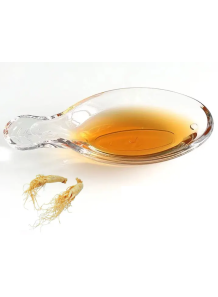RareGinseng® All-K
- Product Code: 125676
a mixture of all Rare Ginsenosides Rg2,Rg3,Rg4,Rg5,Rg6, including very high concentration of Compound K
Compound K , minimum 4000ppm
a mixture of all Rare Ginsenosides Rg2,Rg3,Rg4,Rg5,Rg6, including very high concentration of Compound K
Compound K , minimum 4000ppm
RareGinseng® All-K is a mixture of all Rare Ginsenosides Rg2,Rg3,Rg4,Rg5,Rg6, including very high concentration of Compound K
Break down of Rare Ginsenosides components in RareGinseng® All-K:
1. Compound K , minimum 4000ppm
2. Rare Ginsenosides Rg2+Rg4+Rg6 , minimum 11000ppm
3. Rare Ginsenosides Rg3+Rg5 , minimum 7000ppm
(This product does not include Ginsenosides F2, if you also need GF2, please choose RareGinseng®-GF2
Compound K is the element with the highest value. Obtained from the extraction of all types of ginseng. From the research it was found that Highly effective in creating a protective skin barrier (skin barrier).
From the research document "Compound K improves skin barrier function by increasing SPINK5 expression" (please download from the attached document)
Natural Products Research Institute, Korea Institute of Science and Technology, Gangneung 25451, Republic of Korea 2Department of Life Science, College of Bio-Nano Technology, Gachon University, Seongnam, 13120, Republic of Korea 3Department of Biomedical Chemistry, College of Biomedical & Health Science, Konkuk University, Chungju, Republic of Korea 4 College of Pharmacy, Sookmyung Women's University, Seoul, 04310, Republic of Korea
1. Compound K increases the expression of SPINK5 (serine protease inhibitor Kazal type-5), which plays a crucial role in maintaining skin barrier function.
2. By increasing SPINK5 levels, compound K inhibits the activity of proteases like kallikreins (KLK5, KLK7) that degrade desmosomal cadherins and lead to disruption of the skin barrier.
3. In UVB-irradiated and atopic dermatitis mouse models, compound K treatment:
- Restored SPINK5 expression which was reduced by UVB or DNCB (atopic dermatitis inducer)
- Decreased markers of skin barrier disruption like transepidermal water loss and epidermal hyperplasia
- Normalized the expression of proteins involved in desquamation (shedding of corneocytes from stratum corneum)
4. Compound K improved skin hydration, prevented excessive skin dryness and scaling caused by UVB damage or atopic dermatitis.
In summary, the key skin benefit of compound K is enhancing skin barrier function and preventing barrier disruption by regulating the SPINK5 pathway, making it a potential therapeutic for conditions like atopic dermatitis and UV-induced barrier damage.
From the research document "The skin protective effects of compound K, a metabolite of ginsenoside Rb1 from Panax ginseng" (please download from the attached document)
Department of Genetic Engineering, Sungkyunkwan University, Suwon, Republic of Korea 2 Material Lab, Basic Research & Innovation Division, R&D Center, AmorePacific Corporation, Republic of Korea 3Department of Physiology, College of Veterinary Medicine, Chonbuk National University, Iksan, Republic of Korea 4Department of Engineering Chemistry, Chungbuk National University, Cheongju, Republic of Korea
1. Antiaging and wrinkle prevention effects:
- Suppressed the expression of aging factors like matrix metalloproteinase-1 (MMP1) and cyclooxygenase-2 (COX-2) induced by UVB irradiation.
- Recovered the expression level of type I collagen, which is reduced by UVB irradiation.
2. Skin hydrating effects:
- Increased the mRNA expression levels of skin hydrating factors like filaggrin, transglutaminase, hyaluronic acid synthases-1 and -2.
- The hydrating effects were mediated through activating IκBα, JNK, and ERK pathways.
3. Effects on melanogenesis:
- Increased intracellular melanin content in B16F10 melanoma cells, but did not affect melanin secretion or tyrosinase activity.
- This suggests compound K may have a photoprotective effect against UV damage rather than a whitening effect.
4. Overall, the study suggests compound K from ginseng could be used as an ingredient in cosmetics for UV protection, anti-wrinkling, and improving skin hydration. The melanogenic effect also indicates potential for treating vitiligo.
In summary, the major skin benefits demonstrated were anti-aging, hydrating, and providing photoprotection through modulating melanogenesis, making compound K a promising natural compound for skin care applications.
Use: for wrinkle reduction products Available in the form of gel, serum, lotion or cream.
How to mix: The temperature of cosmetics must be below 40 °C
Utilization rate: 0.1-5% (recommend 3%)
Product characteristics: Yellow to light brown liquid
Solubility: can dissolve in water
Storage: For long-term storage keep in refrigerator temperature 4 °C -8 °C At least 24 months from the date of manufacture.
INCI Name : Butylene Glycol (and) Hydrolyzed Ginseng Saponins
Preservative-free
| Mechanism | - |
| Appearance | - |
| Longevity | - |
| Strength | - |
| Storage | - |
| Shelf Life | - |
| Allergen(s) | - |
| Dosage (Range) | - |
| Recommended Dosage | - |
| Dosage (Per Day) | - |
| Recommended Dosage (Per Day) | - |
| Mix Method | - |
| Heat Resistance | - |
| Stable in pH range | - |
| Solubility | - |
| Product Types | - |
| INCI | - |
Purchase History for
Cart
No products



